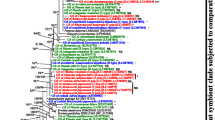Abstract.
At least 12 termite gut protists have been named because of their bacterial symbionts. Dozens more species are diagnosed by epi- and endosymbionts and more still have regular bacterial associations referred to in their species description. Molecular systematic studies have begun to identify these bacteria, but the ecological relations with their protist bionts are still unknown. Recent findings of acetogenic spirochetes in termite guts may explain the peculiar arrangement of spirochetes on some of these protists. Other bacteria function as motility or chemotactic symbionts of these protists. The size and shape of the parabasal body, a Golgi complex, are morphological characters of the Parabasalia (trichomonads, hypermastigids) that may be influenced by regular, heritable epi- and endosymbiotic bacteria.
Similar content being viewed by others
Author information
Authors and Affiliations
Additional information
Electronic Publication
Rights and permissions
About this article
Cite this article
Dolan, M.F. Speciation of termite gut protists: the role of bacterial symbionts. Int Microbiol 4, 203–208 (2001). https://doi.org/10.1007/s10123-001-0038-8
Received:
Accepted:
Published:
Issue Date:
DOI: https://doi.org/10.1007/s10123-001-0038-8




